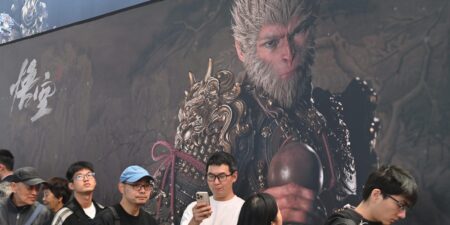This article is part of “Behind the Wheel,” a series about the highly competitive and high-tech world of Formula 1.
It’s been an eventful year for Formula 1.
In addition to the drama that unfolds outside the track, F1 fans have been treated to competitive races and a legitimate battle for the drivers and constructors championships.
The season is entering the home stretch — this weekend’s US Grand Prix kicks off the final six races of the year. Here are the seven major plotlines that have defined the season and how they could affect the sport for years to come.
1. Lewis Hamilton joins Ferrari in a flashy partnership
Driver shake-ups were happening before the season even began. In early February, the Formula 1 champion Lewis Hamilton announced he would depart Mercedes at the end of the season to join Ferrari in 2025.
With Mercedes, the British driver captured six drivers championships, but a string of down years led him to take a risk by joining the famed Italian squad.
With Ferrari looking fairly competitive this season — and Hamilton having a resurgent year, capturing two race victories — the pairing could provide fireworks in 2025.
2. Red Bull is no longer dominant
For the past three seasons, Max Verstappen and Red Bull have annihilated the competition. This year started off similarly: The Dutch phenom captured five victories in the first seven races.
Things changed at the Miami Grand Prix in early May, when McLaren’s Lando Norris comfortably bested Verstappen to capture his first career win. Since then, Red Bull has been on the back foot, and Verstappen hasn’t stood on the top step of the podium for the past eight races.
Preseason harassment allegations against Red Bull’s team principal, Christian Horner, and the departure of its chief engineer, Adrian Newey, have contributed to a downturn for the team. Though Verstappen still seems destined to win his fourth individual title, McLaren has taken the lead in the constructors championship, and Ferrari and Mercedes seem to have caught up.
With regulations staying put for 2025, next season seems poised to be an open battle for both championships.
3. McLaren emerges as a legitimate contender
No team has been hotter in Formula 1 than McLaren, which is having a remarkable turnaround.
Last season, the famously papaya-colored squad looked like a backmarker, finishing near the bottom of the pack in the first few races. But under the guidance of a new team principal, Andrea Stella, McLaren has emerged as the team to beat. Its drivers Lando Norris and Oscar Piastri have collected a combined five race victories this year.
McLaren has leapfrogged Red Bull for first in the constructors championship and seems poised for continued success.
4. Aston Martin becomes a threat after signing the famed engineer Adrian Newey
Perhaps no name carries as much weight in Formula 1 as Adrian Newey. The 65-year-old British engineer wins everywhere he goes.
Since beginning his career in Formula 1 in 1980, he has designed cars that have won 13 drivers championships and 12 constructors championships. He became one of the most sought-after free agents when he announced this year that he’d depart Red Bull. Aston Martin, owned by the billionaire Lawrence Stroll, ultimately snatched him up.
With new regulations set to take effect in 2026, Aston Martin is already a clear favorite to design a top-performing car. And with the two-time champion Fernando Alonso on its roster, the team could be poised for major success in two seasons’ time.
5. The Daniel Ricciardo era ends
In a surprising midseason driver swap, Daniel Ricciardo was cut from RB F1, Red Bull Racing’s sister team.
The decision came after a mostly down year for Ricciardo, who could not seem to keep up with his teammate, the Japanese driver Yuki Tsunoda.
Ricciardo had come to represent the sport in many ways thanks to his outsize role in the Netflix docuseries “Drive to Survive.”
Where Ricciardo goes next will be a hot topic of conversation. Other racing disciplines — such as the US-based IndyCar and NASCAR series — likely hope to snatch him up and capitalize on his international star power.
6. F1 embraces a youth movement
Replacing Ricciardo is Liam Lawson, a 22-year-old from New Zealand. He’s one of many young drivers primed for success.
Mercedes announced this year that it would replace Lewis Hamilton with Andrea Kimi Antonelli, an 18-year-old Italian driver who got his first taste of F1 action during a practice session at this year’s Italian Grand Prix.
The Haas F1 team, meanwhile, will bring on Oliver Bearman next season. The 19-year-old English driver impressed this year while replacing Ferrari’s Carlos Sainz for a race as he recovered from appendicitis.
The French team Alpine will enlist the 21-year-old Australian Jack Doohan next season — meaning there will be at least four full-time rookies on the grid next year.
7. More manufacturers join the sport
Last week, Toyota announced it would return to Formula 1, joining forces with the Haas F1 team.
The Japanese manufacturer previously competed for eight seasons in Formula 1 and has recently had a great deal of success in rally and endurance racing. Toyota could help revitalize a Haas team that has often struggled to score points consistently.
Other manufacturers have announced they’re joining the pinnacle of motorsports.
Audi is poised to join Formula 1 in 2026, taking over the Stake F1 Team Kick Sauber. The American manufacturer Ford also plans to partner with Red Bull in 2026 to provide the team with power units.
The influx of manufacturers points to the sport’s growing mainstream popularity, with big-name car companies eager to throw their hats into the ring.
Read the full article here
















